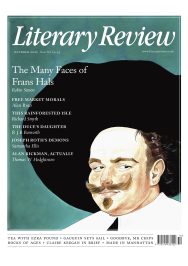Will Wiles
All That Glitters
Lapidarium: The Secret Lives of Stones
By Hettie Judah
John Murray 336pp £20
‘Geology is a story-telling science, requiring great leaps of poetic imagination,’ writes Hettie Judah in Lapidarium: The Secret Lives of Stones. Stones that come to us hard and cold and unchanging are the product of immense geological heat and upheaval. They provide glimpses into the inhuman abyss of time and are windows onto past epochs. And stones and minerals underpin every part of every civilisation, explaining and revealing, showing that the pinnacles of wealth, luxury and artistic achievement are often allied to misery, despoliation and violence.
There is a good deal of geology in Lapidarium, as you’d expect, but it is not a scientific book in character. Judah is an art critic and there’s also a lot of art, but that does not dominate it either. In essence, it is a storybook, and a delightful one, composed of sixty short essays, each on a different type of stone. There are all the big names you’d expect – ruby, coal, moon rock – and many more that are unfamiliar: Haüyne, Lewisian gneiss, phonolite porphyry.
Whenever Judah looks like heading into obvious territory, she swerves into something unexpected. Diamonds are lipophilic: they are attracted to fat and grease. The association between diamonds and love might just be shrewd marketing by jewellers, but Judah suggests that their association with bad luck might also stem from sales patter, the connection talked up by auctioneers to add gothic lustre to indifferent stones.
Other stones have far more ancient symbolism. Jadeite – the word ‘jade’ actually signifies two different stones, jadeite and nephrite – was prized by the Mayan civilisation for its association with ripening maize, the staple that was for Mayans the stuff of life. But that’s not all. ‘Dense and

Sign Up to our newsletter
Receive free articles, highlights from the archive, news, details of prizes, and much more.@Lit_Review
Follow Literary Review on Twitter
Twitter Feed
Under its longest-serving editor, Graydon Carter, Vanity Fair was that rare thing – a New York society magazine that published serious journalism.
@PeterPeteryork looks at what Carter got right.
Peter York - Deluxe Editions
Peter York: Deluxe Editions - When the Going Was Good: An Editor’s Adventures During the Last Golden Age of Magazines by Graydon Carter
literaryreview.co.uk
Henry James returned to America in 1904 with three objectives: to see his brother William, to deliver a series of lectures on Balzac, and to gather material for a pair of books about modern America.
Peter Rose follows James out west.
Peter Rose - The Restless Analyst
Peter Rose: The Restless Analyst - Henry James Comes Home: Rediscovering America in the Gilded Age by Peter Brooks...
literaryreview.co.uk
Vladimir Putin served his apprenticeship in the KGB toward the end of the Cold War, a period during which Western societies were infiltrated by so-called 'illegals'.
Piers Brendon examines how the culture of Soviet spycraft shaped his thinking.
Piers Brendon - Tinker, Tailor, Sleeper, Troll
Piers Brendon: Tinker, Tailor, Sleeper, Troll - The Illegals: Russia’s Most Audacious Spies and the Plot to Infiltrate the West by Shaun Walker
literaryreview.co.uk